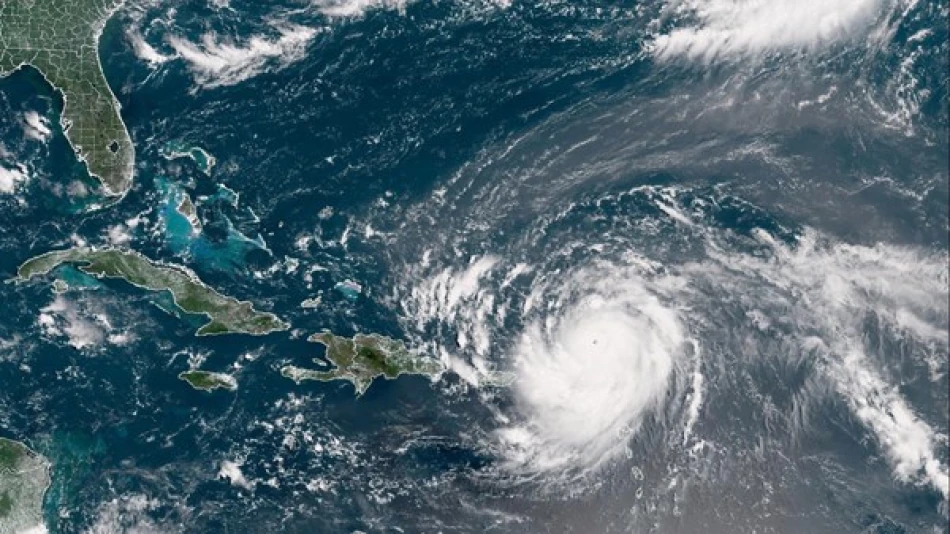
Powerful Hurricane 'Irina' Intensifies in the Atlantic Ocean
Hurricane Erin Explodes into Dangerous Category 5 Storm, Threatening Caribbean and U.S. East Coast
Hurricane Erin has rapidly intensified into a catastrophic Category 5 storm with winds reaching 158 mph, marking an alarming start to the 2025 Atlantic hurricane season. The monster storm is currently positioned 106 miles north of Anguilla and poses significant threats to multiple Caribbean territories and the U.S. Eastern Seaboard, raising concerns about both storm surge devastation and potential wildfire outbreaks.
Unprecedented Early Season Intensity
The transformation of Erin into the first major hurricane of 2025 represents a concerning trend of rapid intensification that has become increasingly common in recent Atlantic hurricane seasons. Category 5 storms, with sustained winds exceeding 157 mph, are relatively rare but devastating when they occur. The storm's current wind speeds of 158 mph place it among the most dangerous hurricanes on record for this early in the season.
This rapid escalation mirrors patterns seen in recent years, including Hurricane Ian in 2022 and Hurricane Dorian in 2019, both of which underwent explosive strengthening before causing catastrophic damage across the Caribbean and southeastern United States.
Wide-Ranging Impact Across Caribbean and Beyond
Immediate Threat Zone
The National Hurricane Center has issued warnings for dangerous surf conditions affecting the northern Leeward Islands, Virgin Islands, Puerto Rico, Hispaniola, and the Turks and Caicos Islands over the coming hours. These areas face the dual threat of destructive storm surge and torrential rainfall that could trigger flash flooding and landslides in mountainous regions.
Extended Coastal Concerns
Erin's influence extends far beyond its immediate path, with dangerous surf conditions expected to reach the Bahamas, Bermuda, and the entire U.S. East Coast. This widespread impact demonstrates the far-reaching effects that major hurricanes can have on maritime commerce, coastal tourism, and shipping lanes throughout the Atlantic basin.
Economic and Infrastructure Implications
The storm's trajectory through some of the Caribbean's most tourism-dependent economies could deliver significant economic blows to islands still recovering from previous hurricane seasons. Puerto Rico, which has faced ongoing infrastructure challenges following Hurricane Maria in 2017, remains particularly vulnerable to extended power outages and communication disruptions.
For the U.S. mainland, while Erin is forecast to remain offshore, the dangerous surf conditions pose risks to coastal businesses during what is typically peak summer tourism season. Beach closures and maritime restrictions could impact everything from fishing operations to recreational boating along the Eastern Seaboard.
Climate Change Fingerprints
Erin's rapid intensification aligns with scientific predictions about how climate change is affecting hurricane behavior. Warmer ocean temperatures provide more energy for storm development, while changing atmospheric patterns can create conditions conducive to explosive strengthening. The early appearance of such an intense storm in 2025 may signal another active and potentially destructive hurricane season ahead.
Forecast Track and Timing
Current projections show Erin moving north of the Leeward Islands before tracking northward between the U.S. East Coast and Bermuda by Monday. This path would spare densely populated coastal areas from direct impact while still generating dangerous conditions across a vast area of the western Atlantic.
Heavy rainfall is expected to continue affecting the Leeward Islands, Virgin Islands, and Puerto Rico through Sunday, with accumulations that could exacerbate flooding in areas with poor drainage infrastructure. The storm's forward speed will be crucial in determining how much rainfall accumulates in any single location.
Emergency management officials across the region are monitoring Erin's progress closely, as even slight shifts in the storm's path could bring dramatically different outcomes for vulnerable island communities and coastal populations.
 Layla Al Mansoori
Layla Al Mansoori







